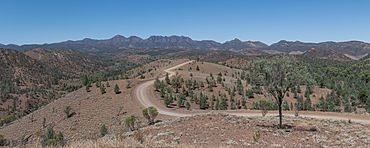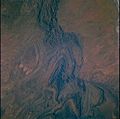Ikara–Flinders Ranges National Park facts for kids
Quick facts for kids Ikara–Flinders Ranges National ParkSouth Australia |
|
|---|---|
|
IUCN Category II (National Park)
|
|

Razorback Lookout in Ikara–Flinders Ranges National Park
|
|
| Nearest town or city | Hawker |
| Established | 1 January 1945 |
| Area | 933.97 km2 (360.6 sq mi) |
| Managing authorities | National Parks and Wildlife Service South Australia |
| Website | Ikara–Flinders Ranges National Park |
| See also | Protected areas of South Australia |
The Ikara–Flinders Ranges National Park is a special place in South Australia. It's about 400 km north of Adelaide. This park is part of the state's largest mountain range, called the Flinders Ranges.
The park covers a huge area of 912 km². It's located northeast of the small town of Hawker. Two famous walking and cycling paths, the Heysen Trail and Mawson Trails, go right through the park.
The most famous landmark here is Wilpena Pound. It's a giant, natural bowl-shaped area, almost 80 km² in size. Inside Wilpena Pound is St Mary Peak, the highest point in the range, standing at 1,170 m (3,840 ft) tall. In 2016, the park's name was changed to include Ikara. This is an Adnyamathanha word meaning "meeting place," which is the traditional name for Wilpena Pound.
You can reach the main park centre at Wilpena Pound by a sealed road from Hawker. Other parts of the park have unsealed roads. These are usually fine for regular cars, but can be tricky in bad weather or after heavy rain.
The park has many amazing spots to see. These include lookouts, scenic views, small canyons, and unique rock shapes. Some popular places are Wilpena Pound, Wilkawillina Gorge, Brachina Gorge, and Arkaroo Rock. You can also find old stone ruins from early European settlers and Aboriginal rock art sites. Just outside the park, there's a cool rock formation called the Great Wall of China. You can even camp in many places within the park.
The park is looked after by the National Parks and Wildlife Service South Australia. This group is part of the Department for Environment and Water.
Contents
How the Mountains Formed
The Flinders Ranges are made mostly of old rocks that have been folded and broken. These rocks were laid down in a huge basin a very long time ago, about 540 million years back. Imagine a giant, ancient ocean floor where layers of mud and sand built up.
Later, around 540 million years ago, a big event called the Delamerian orogeny happened. This was like a giant squeeze that pushed and folded these rock layers, creating a huge mountain range. Over millions of years, wind and water have worn down these mountains, making them lower than they once were.
The high parts of the Flinders Ranges, like the walls of Wilpena Pound, are made of strong rock called quartzite. This same rock forms many other high areas in the Flinders, including the Gammon Ranges.
Plants and Animals
The plants in the Flinders Ranges are mostly types that can live in a dry environment. You'll see trees like cypress-pine, mallee (a type of eucalyptus), and black oak. In wetter spots, especially near Wilpena Pound, you might find grevilleas, Guinea flowers, lilies, and ferns. Near permanent water sources like springs and waterholes, you'll see reeds and sedges.
Amazing Animals of the Park
The park is home to many interesting animals. After dingos were removed and permanent waterholes were made for farm animals, the number of red kangaroos, western grey kangaroos, and euros grew a lot. The yellow-footed rock-wallaby almost disappeared when Europeans arrived because of hunting and foxes. But now, their numbers are stable.
Other small marsupials (pouched animals) you might find include dunnarts and planigales. The echidna is the only monotreme (a mammal that lays eggs) in the park. Many kinds of insect-eating bats also live here.
The park has many reptiles like goannas, snakes, dragon lizards, skinks, and geckos. You might also spot the streambank froglet, a small frog found only in this area.
Birds of the Flinders Ranges
The park is a great place for birdwatching! You can see many different kinds of parrots, emus, and the powerful wedge-tailed eagles. There are also some waterbirds. BirdLife International has named this park an Important Bird Area (IBA). This is because it has a healthy population of the short-tailed grasswren, a special bird found only in certain areas.
Historic Places
The national park has several sites that are important for their history. These include:
- Eddie Pumpa Outstation
- Hayward Homestead Ruins
- Impact Ejecta Horizon Late Precambrian Shales Geological Site
- Enorama Mail Station and Rubbish Dump
- Oraparinna Diapir
- Wilpena Homestead Complex
- Wilpena Pound (geological landform)
- Stromatolites in the Precambrian Trezona Formation, Enorama Creek
- Wills Homestead Complex Ruins
- Appealinna Mine Ruins and Miners Hut
- Wilkawillina Archaeocyathae Geological Site
- Dingley Dell Homestead Ruins
- Hill's Cottage, Wilpena Pound
- Enorama Diapir
- Oraparinna Station Blacksmith's Shop
Images for kids
See also
 In Spanish: Parque nacional Montes Flinders para niños
In Spanish: Parque nacional Montes Flinders para niños
- Arkaroola, a wildlife sanctuary
- Cazneaux Tree, an historic tree near Wilpena Pound
- Mawson Plateau
- Mount Chambers Gorge
- Protected areas of South Australia
- Wapma Thura–Southern Flinders Ranges National Park
- Vulkathunha-Gammon Ranges National Park






